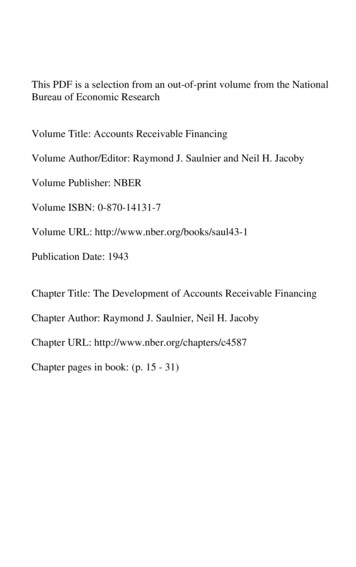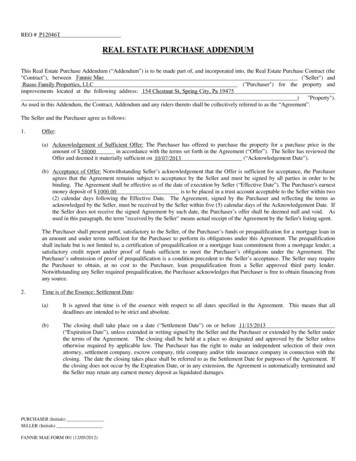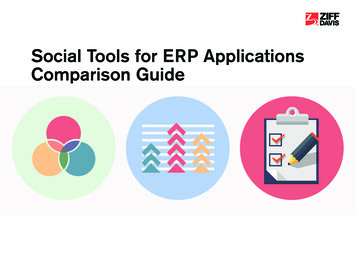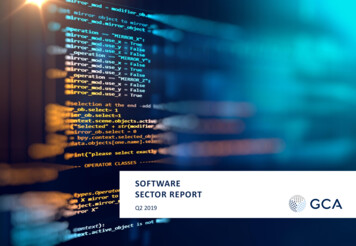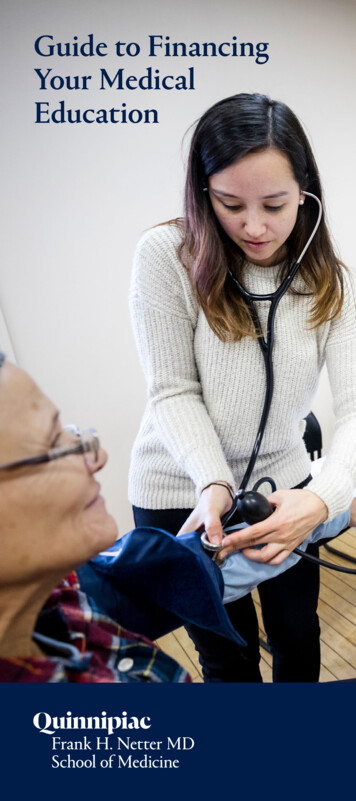
Transcription
Guide to FinancingYour MedicalEducation1
Guide to Financing YourMedical EducationDear Student,At the Frank H. Netter MD School of Medicine at QuinnipiacUniversity, we recognize that financing a medical educationis a significant undertaking. Therefore, we have provided thisguide to help you understand your financial aid eligibility andfinancing options. We recommend that this document be keptas a reference throughout medical school.Please be sure to read all the information you receive from ouroffice and check your Quinnipiac email often, as most universityoffices will communicate with you via this method. You mustreapply for financial aid each year if you need assistance to payfor medical school. We recommend filing your Free Applicationfor Federal Student Aid (FAFSA) by March 1 to ensure timelyprocessing of your financial aid. Our Federal School Codeis 001402.We encourage you to call, email, Zoom, write or visit our office toaddress any questions or concerns you may have regarding yourfinancial aid. We will do our best to ensure that your questionsare answered and that you have a clear understanding of how thefinancial aid process works. We look forward to working with youto help you realize your educational goals.Sincerely,Sylvie Hangen, MBA ’19Director of Financial AidQuinnipiac UniversityFrank H. Netter MD School of MedicineOffice of Financial Aid MNH-211275 Mount Carmel AvenueHamden, CT 06518-1908T 203-582-5100 or 855-582-5100F 203-582-4511finaidmedicine@qu.eduOffice location:370 Bassett RoadNorth Haven, CT 064732Guide to Financing Your Medical Education
ContentsGuide to Financing Your Medical Education. 2Your Electronic Financial Aid Offer Letter. 4Estimated Cost of Attendance. 5Family Resources. 6Institutional Scholarships and Grants. 6Outside Scholarships.7Federal Financial Aid .7Annual Unsubsidized Loan Limits. 8Private Loan Funding. 9Verification. 9Helping You Manage the Cost of YourMedical School Education. 10Standards for Satisfactory Academic Progressfor Financial Aid Recipients and Applicants. 10Receiving Your Aid: The Role of theOffice of the Bursar .12Quinnipiac UniversitySchool of Medicine Refund Policy.12Return of Title IV Funds.14Frequently Asked Questions.15Contact Information.17Websites.17Financial Aid Checklist. 19Family Educational Rights & Privacy Act (FERPA). 193
Your Electronic Financial AidOffer LetterYour financial aid offer letter contains information regardingyour cost of attendance, the types of aid for which you areeligible, and the amount offered with a breakdown of theamounts by semester—Semester 1 and Semester 2. The amountsoffered are contingent upon your actual enrollment, continuingattendance, satisfactory academic progress (please see page 10 ofthis guide) and verification of information on the FAFSA.Official Financial Aid Offer LettersThe Office of Financial Aid provides financial aid offer letterselectronically via your Quinnipiac email account. Please notethat offer letters are provided to admitted students who havesubmitted all of the necessary documents to process theirfinancial aid application. Students will receive a notice via emailwith instructions on how to access their electronic offer letter.After you receive your offer letter, you need to either accept,decline or reduce your offer where applicable, and submit yourresponse within 15 days of receipt. If you are a first-time borrower,you also will be asked to complete loan entrance counseling,as well as the annual student loan acknowledgment and sign aDirect Loan Master Promissory Note (MPN).Revised Offer LettersRevisions to an offer letter may be necessary due to a changein circumstances, such as the receipt of an outside scholarship,verification updates or changes in a budget item, such as housingplans. Any change to your offer letter will be reflected in a revisedfinancial aid offer letter. Revisions are sent throughout the year,as necessary, and must be submitted within 15 days of receipt. Beaware that only aid you have accepted on your offer letter will becredited to your student account.It is your responsibility to immediately notify the School ofMedicine Office of Financial Aid in writing if you receive additionalfunding from an outside source or change your enrollment orhousing status.4Guide to Financing Your Medical Education
Estimated Cost of AttendanceYour financial aid offer letter lists your cost of attendance basedon the information you provided on your FAFSA regardinghousing plans. There are two categories in your total cost ofattendance budget: direct and indirect costs.1. Direct costs are paid directly to the university and areincluded in your online billing statement from the QuinnipiacUniversity Office of the Bursar. These include such items astuition, student fees and health insurance.2. Indirect costs are expenses that you incur throughout theacademic year that are not billed through the university, suchas a computer, supplies, transportation expenses and livingexpenses. All of these estimates are for educational expensesand are used to calculate financial aid eligibility.Visit the website at qu.edu/med/costs for additionalinformation on costs.Financial aid budgets do not allow for noneducational costsand are based on expenses for the student only. We realizethat personal lifestyle, as well as the cost of supplies and livingexpenses, will vary from student to student. To remain fair andequitable to all financial aid recipients, the School of MedicineOffice of Financial Aid uses a standard budget for items suchas a computer and supplies and for living expenses for eitheroff-campus room and board or living at home. We do not adjustthese standard budgets based on actual amounts spent ontransportation, computer and supplies or living expenses. Theoff-campus budget reflects the expectation that you will haveat least one roommate. Living expense figures are reviewed andupdated annually and are based on estimates provided by theBureau of Labor Statistics and Consumer Price Index.5
Family ResourcesNeed-based financial aid is based upon the cost of attendanceat the Frank H. Netter MD School of Medicine at QuinnipiacUniversity and a family’s calculated contribution to educationalcosts. Families are expected to make a maximum effort to meeteducational expenses.How Financial Need Is DeterminedThe School of Medicine determines your need for financialassistance using the following formula:Cost of attendance (COA) minus expected family contribution(EFC) needIt is important to note that in medical school, students may nothave their need fully met. Therefore, you may need to borrowadditional funds through a Federal Graduate PLUS Loan,alternative private loan or apply for the university’s payment planto help finance any remaining balance.Expected Family ContributionThe Expected Family Contribution is derived from the dataprovided each year on your FAFSA, including income, assets,family size and number of people in college. It does not allow forconsumer-type choices, credit card debt, mortgage expenses, etc.Your EFC is considered a measurement in helping us determineyour level of financial need.Institutional Scholarships and GrantsThe university offers academic, need-based and merit scholarshipsup to full tuition with special consideration given to individualsfrom disadvantaged backgrounds and students interested inprimary care. All accepted students who have completed theirFAFSA will be considered for academic, merit and need-basedgrant aid.Please visit the website at qu.edu/med/scholarships foradditional information.6Guide to Financing Your Medical Education
Outside ScholarshipsScholarships and grants can be offered to outstanding students byorganizations other than the School of Medicine. Corporations,foundations, employers, state, national and professionalassociations, civic organizations and clubs have their ownapplication and selection criteria for offering private funds. TheSchool of Medicine encourages all students to research and applyfor outside scholarships for which they may be eligible. To assistyou, we will list any available scholarships on the financial aidwebsite as we are notified of them. We also recommend the freescholarship web resources listed on page 18 of this guide. Studentsare responsible for all application, renewal and disbursementpaperwork.Federal regulations require that the Financial Aid Officecoordinate all sources of funding to ensure that you are notreceiving any aid for which you may not be eligible or thatexceeds your cost of attendance. For this reason, you are requiredto notify the Financial Aid Office of any outside resource you willbe receiving that is not already listed on your electronic financialaid offer letter.Federal Financial AidThe U.S. government provides loans for medical students.To be eligible, the student must be a U.S. citizen, permanentresident or eligible non-citizen. The funds described in thefollowing section are available from the federal government.Visit qu.edu/med/loans for more information.The Federal Direct Unsubsidized Loan is available for medicalstudents who are matriculated in a degree-granting programand enrolled at least half time each semester. The borrower isresponsible for all interest that accrues and can choose to eitherpay the interest while in school or add any deferred interest tothe principal balance of the loan (“capitalization”). When interestis capitalized, the principal balance is increased by the amount ofunpaid interest.The interest rate is set each year on July 1 based on a formulausing the Treasury note and an additional percentage (July1 rate of 10-year Treasury note 3.6% rate for the newacademic year, with a capped rate of 9.5%). Visit our website atqu.edu/med/loans for current interest rates and origination feeson federal loans. Federal Direct Loans are subject to fees, whichare deducted from loan proceeds prior to the disbursement offunds. Borrowers are responsible for repayment of all such fees.Students receive a six-month grace period after they graduate,drop below half-time status or withdraw.7
The Federal Direct Graduate PLUS Loan is available formedical students who are matriculated in a degree-grantingprogram, are enrolled at least half time each semester, havecompleted a FAFSA, applied for their annual Federal DirectUnsubsidized Loan maximum, and meet the credit criteria.The maximum loan limit is the cost of attendance minusother aid received. The interest rate is fixed each year. Visit thewebsite at qu.edu/med/loans for current interest rates andorigination fees on federal loans. Loan fees are deducted fromloan proceeds prior to the disbursement of funds, and borrowersare responsible for repayment of all such fees. Repayment onFederal Direct Graduate PLUS loans begins after the seconddisbursement; however, students enrolled at least half time mayrequest deferment. Students may elect to receive a six-monthgrace period after they graduate, drop below half-time statusor withdraw. Visit the website at qu.edu/med/loans for moreinformation.Students in default on prior student loans are not eligible toreceive additional federal loans or other financial aid from theSchool of Medicine. Arrangements must be made with the lenderto resolve any defaulted loans before eligibility can be restored.Annual Unsubsidized Loan LimitsGraduate/Professional Medical Students Unsubsidized Total: 40,500–47,167 Aggregate Limit: 224,000Amounts vary based on length of academic year.If you are offered a Federal Direct Unsubsidized Loan, you needto accept, decline or reduce these funds on your electronicfinancial aid offer letter. The loan process is initiated by youracceptance of the Federal Direct Unsubsidized Loan on yourelectronic offer letter. First-time borrowers must complete,entrance counseling, the annual student loan acknowledgmentand the electronic Master Promissory Note (MPN) before fundscan be credited to your student account. Visit studentaid.govto access the link to complete all requirements. You will receivea notice of disclosure once the loan is processed indicating thescheduled disbursement dates. Loan proceeds are disbursedin two installments through electronic funds transfer at thebeginning of each semester.All School of Medicine students borrowing Federal DirectUnsubsidized and Graduate PLUS Loans for the first time alsoare required to complete mandatory loan entrance counseling,the annual student loan acknowledgement as well as a GraduatePLUS Loan Master Promissory Note (MPN). The counselingmust be completed prior to the university receiving loan funds.Go to studentaid.gov to complete all requirements online.8Guide to Financing Your Medical Education
Private Loan FundingIn addition to the Federal Direct loan programs, privateeducational loans are available for medical students. Borrowereligibility, co-signer requirements, interest rates, maximum loanlevels and repayment options vary according to the program. Visitqu.edu/med/loans for information. You may consult directlywith each lender for specific terms and eligibility.VerificationMedical students are subject to a process called verification.During the verification process, information provided on yourFAFSA is matched with the information you filed on your federalincome tax returns. This process requires that you complete anIRS data match, provide a copy of your federal tax transcript,complete a federal verification worksheet, signed copies of yourcurrent federal tax returns with all attachments and otherdocumentation as requested. If you get a letter requestingthis information, we ask that you provide it to us as quickly aspossible so we may proceed with the processing of your file. Adelay in the receipt of this information almost always translatesto delays in the confirmation, processing and disbursing of yourfinancial aid. As a result, late fees and holds may be placed onyour account so it is important that you pay close attentionto the correspondence you receive from our office to avoid anyunnecessary problems.As a part of our verification process, the Office of Financial Aidregularly selects new students who are receiving grant aid. Wefeel this is an important part of the financial aid process, whichlets us establish an accurate “base” to build upon in subsequentyears. Incoming students will begin to receive notifications ofverification after they have left their deposit acknowledging theiracceptance to the School of Medicine.And finally, if you are having difficulty providing the requestedinformation, please do not hesitate to contact our office forassistance.9
Helping You Manage the Cost of YourMedical School EducationThe university offers payment plans, which allow you to registerfor courses and pay in installments. A nominal installment fee ischarged. Visit qu.edu/bursar for more information.Various education assistance programs are administered bythe Department of Veterans Affairs. They provide benefits toveterans, service members and some dependents of veteranswishing to pursue an education. Quinnipiac University is aparticipant in the Yellow Ribbon Program. Visit qu.edu/militaryfor more information.Standards for Satisfactory AcademicProgress for Financial Aid Recipientsand ApplicantsMedical students who wish to receive assistance through anyfederal, state or institutionally supported scholarships, grantsor loans must comply with the following Satisfactory AcademicProgress standards. Satisfactory Academic Progress measures thequality of the academic work, and the rate of progress toward theDoctor of Medicine (MD) degree. Students who fail to complyare not eligible for financial aid.1. Qualitative MeasurementThe quality of a student’s academic work and professionalism.All medical students must maintain professionalism as defined(by the promotions committee) as well as passing grade(s) at theend of each academic year.2. Quantitative MeasurementThe rate of a student’s progress toward a degree. Students mustcomplete a minimum of two-thirds (.067) of the blocks for whichthey are enrolled and be making progress to complete theirdegree within the six-year rule.Satisfactory Academic Progress is measured once per year atthe end of the second semester. To be considered satisfactory,students must successfully complete or remediate all of theacademic work toward their medical degree during a period ofconsecutive and required blocks and semesters.Students may not receive financial aid for more than 150 percentof the published program length (maximum time to completeprogram is 6 years).Please note that both the qualitative and quantitativemeasurements indicate the passing grade(s) as well as the numberof completed blocks needed to meet satisfactory academic10Guide to Financing Your Medical Education
progress requirements for financial aid and do not reflect themedical school’s recommended requirements.3. Implementation of the Satisfactory AcademicProgress PolicySatisfactory Academic Progress is reviewed once per year, atthe conclusion of the second semester after final grades havebeen posted.Students whose performance or progress does not meet therequired standards will be notified by the director of financial aidand will be considered ineligible for aid, including federal, state,institutional and most private loans. Students with financialaid applications on file for the upcoming year will receive acommunication indicating the loss of aid after final grades areposted. Students who are not making satisfactory progress andhave not filed an application for financial aid will not receive thiscorrespondence until the financial aid application has been filed.Students may appeal their loss of aid based on extenuatingcircumstances. Appeals must be submitted in writing to thedirector of financial aid and will be reviewed for decision by theFinancial Aid Appeals Committee. Students who do not appeal,or whose appeal is denied, will not regain financial aid eligibilityuntil all academic standards are met. Summer remediationcourses may be considered in repairing deficiencies.If an appeal is granted, the student will be placed on financialaid probation for up to one year, and an academic plan will beprescribed for the student to follow. The student’s academicprogress will be reviewed at the end of the probationary termand they must have met the conditions of the academic plan toreceive financial aid. A student who fails to meet these conditionswill lose eligibility for financial aid. Additional appeals will not beconsidered.11
Receiving Your Aid: The Role of theOffice of the BursarThe Office of the Bursar manages the cashiering, billing,collection, student account services and refund notifications.Students can pay bills, enroll in direct deposit for refunds,obtain payment plan information and seek clarification relatedto Quinnipiac charges from the staff in this office. Students canaccess an online billing statement from the bursar’s office prior toeach semester and are expected to meet their financial obligationswhen they are due.For financial aid recipients, Federal Direct Unsubsidized andGraduate PLUS Loans are credited to student accounts in twoequal disbursements. Private loan borrowers receive a crediton their account when the lender has approved the loan. Thedisbursement dates for all loans occur approximately five daysprior to the start of each semester, provided the student meetsthe offer and enrollment conditions. Federal and private studentloans are disbursed via electronic funds transfer. Students havethe right to cancel a portion of their entire loan at any timeduring the process. When applicable, if loan amounts exceedactual tuition and fee charges, the bursar will process a refundfor student living expenses. Students can sign up to have theirrefunds directly deposited into their personal accounts.Visit qu.edu/bursar for more information.Quinnipiac UniversitySchool of Medicine Refund PolicyThe policy described below applies to students withdrawing fromclasses as well as those students effecting a complete withdrawalfrom Quinnipiac University.Refund Policies Related to Matriculation DepositA new student who has rendered the 100 matriculationdeposit and withdraws from the university prior to April 30will be entitled to a full refund of his/her matriculation deposit.Withdrawals occurring after April 30 will not be entitled to arefund of the matriculation deposit.In all instances noted above, any balance on the student’saccount, less financial aid, will be refunded.Refund Policy Tuition and Related FeesMedical students who withdraw from any of their classes afterthe published “Last Day for Late Registration/Schedule Changes”will not be entitled to any adjustment of their charges for tuitionand fees.12Guide to Financing Your Medical Education
Students who affect a complete withdrawal or leave of absencefrom the university, regardless of the reason, including medical,will be granted a pro rata refund of tuition and fees, less anadministrative fee of 100. Late fees are nonrefundable. The prorata refund will be computed on the following basis:WithdrawalBefore the first week of classPercent refund100%During the first and second week of class80%During the third week of class60%During the fourth week of class40%During the fifth week of class20%After the fifth week of class0%Please note that course fees may not be refunded or proratedunder certain circumstances, such as after the start of thesemester.The date of withdrawal for purposes of calculating the refundis the date on which the student makes formal application forwithdrawal to the Registrar’s Office, or, in the case of medicalleaves of absence, the date the associate dean of student affairsapproves the leave of absence. The refund schedule listed aboveis applied regardless of the reason for withdrawal, includingmedical reasons.Dismissals and SuspensionsA student who is either dismissed or suspended by the universityfor any reason during either academic semester will receive arefund based on the applicable refund percentage in effect atthe time of the student’s dismissal or suspension. In addition,a student who is dismissed or suspended will be charged alladministrative fees and board fees as prescribed.Payment PlanStudents using the university’s payment plan who withdrawduring the refund period should note that their forfeiture willbe computed on the full amount charged regarding tuition andfees, and not on the amount remitted via the payment plan. Inaddition, the 75 service charge for using the payment plan willalso be included in the list of charges. After the applicable refundperiod, the balance due under the payment plan will be due andpayable on the date of withdrawal.13
Return of Title IV FundsIn addition to the university’s refund policy that prorates tuitioncharges during the first five weeks of the semester, the universityis required to return to the federal government that portionof federal aid that is unearned. Title IV funds are based on apayment period or term, and funds must be returned in thefollowing order:1. Federal Direct Unsubsidized Loans2. Federal Direct PLUS LoansPlease note: It is important to understand that if a student’swithdrawal date is on or before the completion of 60 percentof the semester, “unearned aid” will result. If a student hasreceived a refund as a result of aid applied to his/her accountprior to their withdrawal date, the student’s account will show abalance due the university. For more complete information, go toqu.edu/bursar and click on Withdrawal and Refund Policies inthe Policy Information section and then choose the School ofMedicine to see the refund policy.14Guide to Financing Your Medical Education
Frequently Asked QuestionsQ / Will I need to report my parents’ income and assetinformation on the FAFSA?A/ Yes, parent information is required for students who wishto be considered for institutional financial aid (aid given bythe medical school) even though an applicant is consideredindependent for purposes of federal loans.Q / How do I determine the additional amount of fundsI can borrow in a Federal Graduate PLUS or privateeducational loan?A/ You may borrow up to the cost of attendance (COA) minusany other aid received. If your COA equals the amount ofaid on your financial aid offer letter, then you cannot borrowan additional loan. If your COA is larger than the amount ofaid on your financial aid offer letter, then you can borrow upto the difference.Q / Do I have to accept the full amount of the loan offered onmy financial aid electronic offer letter?A/ No, you may accept all or part of the loan offered. Youshould indicate the amount you wish to borrow on yourelectronic financial aid offer letter. For example: If you areoffered 10,000 for the first semester and 10,000 forthe second semester, but you need to borrow only 3,000per semester, replace the 10,000 with 3,000 for eachsemester, accept the offer and submit the response.Q / Can I borrow educational loans for relocation expenses?A/ No, you will need to budget for these expenses usingyour own resources. The maximum amount you canborrow is the cost of attendance minus other aid. The10-month cost-of-attendance budget does not includeyour living expenses for the summer and does not take intoconsideration expenses related to owning a car, relocating toConnecticut, or other debt.Q / I would like to live alone. Can I get an increase to my cost ofattendance?A/ Our academic year budget reflects the expectation thatyou will have at least one roommate and is not increasedif you choose to live alone. You will need to budget for theadditional expenses using your own resources.15
Q / Whom should I contact if I borrowed a Federal Loan as anundergraduate?A/ You must notify your servicer of your return to school toinitiate a loan deferment. The deferment process will haltyour loan repayment obligation so long as you are enrolledat least as a half-time student. You may be required tocomplete deferment paperwork and submit that paperworkto the Office of the Registrar for processing.Q / If I have already started a semester, may I still apply forfinancial aid?A/ Yes, you may apply for financial aid once a semester hasstarted. Keep in mind that all paperwork must be complete,your FAFSA results received by the university, and yourFederal Direct Loan originated prior to the last date ofenrollment for the academic period.Q / How are my Federal Direct Loan funds credited tomy account?A/ Once you have completed your Federal Direct MasterPromissory Note, annual student loan acknowledgmentand entrance counseling, your funds will be disbursed to theuniversity in two equal installments (minus applicable fees)via electronic funds transfer no sooner than 10 days priorto the start of each semester. Loan proceeds are appliedto your account balance. If funds are remaining after theaccount is paid, the Office of the Bursar will issue a refundwithin 14 calendar days either by directly depositing thefunds into your personal account or mailing a check toyour permanent address on file. It is imperative that youmake financial arrangements with your landlord and/orcreditors in advance of the start of class. Refunds, in excessof your institutional charges, will be issued at the time youraccount is in a credit balance position, which can be wellinto the semester. We will make every effort to expedite yourfinancial aid; however, please be aware this is the busiesttime of year for the Department of Education, so please tryto be as timely as possible when submitting your paperwork.Q / What are my repayment options for Federal GraduatePLUS Loans after graduation?A/ You may elect to defer your payments for six months;however, interest will continue to accrue. Beyond that, youshould contact the Department of Education to discussoptions, such as forbearance.Q / Do I have to re-apply for financial aid every year?A/ Yes, you must re-apply for financial aid each year. You mustfile your FAFSA after October 1, and the recommendeddeadline to submit both applications is March 1 each year.16Guide to Financing Your Medical Education
Contact InformationFrank H. Netter MDSchool of MedicineOffice of Financial Aid203-582-5100855-582-5100 (toll-free)Office of Admissions203-582-7766855-582-7766 (toll-free)Office of the RegistrarVeterans BenefitsEnrollment CertificationQuinnipiac UniversityBookstore203-582-8640Public Safety203-582-6200Disability Services203-582-3220Student Health Services203-582-8742203-582-3214Quinnipiac UniversityMain CampusOffice of the Bursar203-582-8200203-582-8650Weather Line203-582-8989WebsitesQuinnipiac University Frank H. Netter MD School ofMedicine Office of Financial Aidqu.edu/med/finaidappDepartment of Education epare/contactombudsmanDepartment of Veterans Affairsgibill.va.govFAFSA on the Webfafsa.govAAMC Financial Information, Resources,Services and Tools (FIRST)aamc.org/services/first/Financial
Sincerely, Sylvie Hangen, MBA '19 Director of Financial Aid Quinnipiac University Frank H. Netter MD School of Medicine Office of Financial Aid MNH-211 275 Mount Carmel Avenue Hamden, CT 06518-1908 T 203-582-5100 or 855-582-5100 F 203-582-4511 finaidmedicine@qu.edu Office location: 370 Bassett Road North Haven, CT 06473
